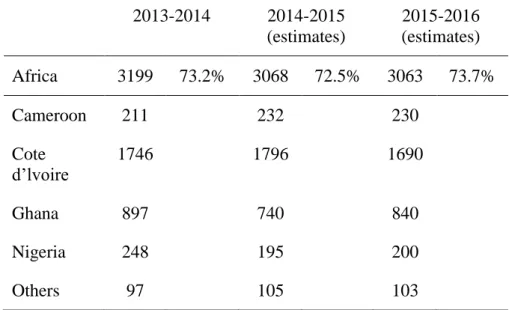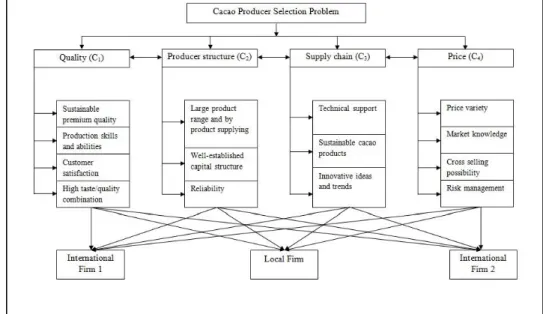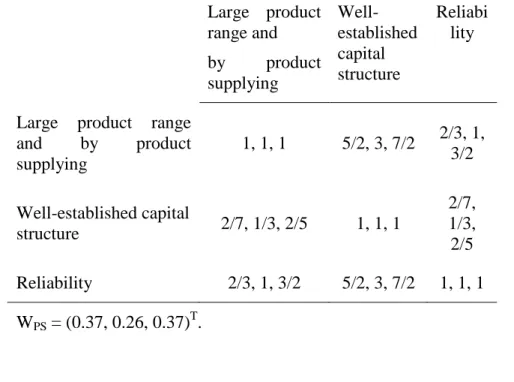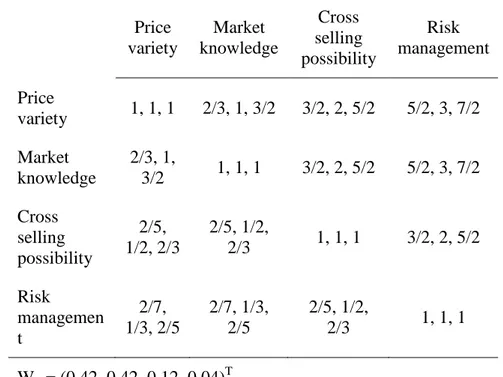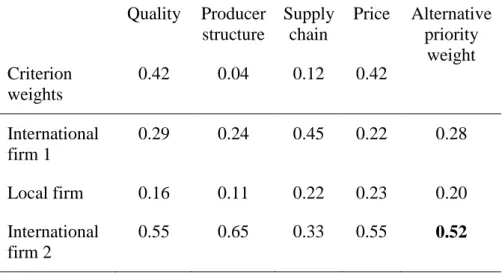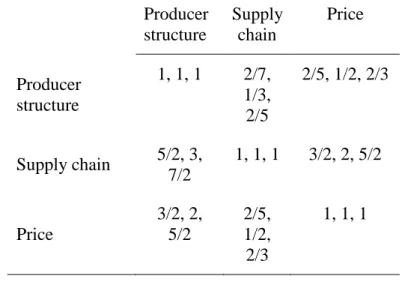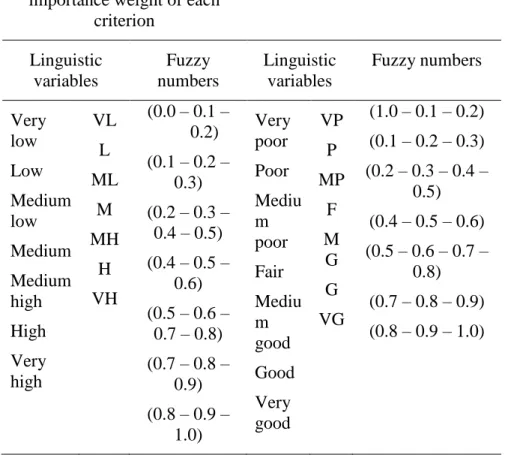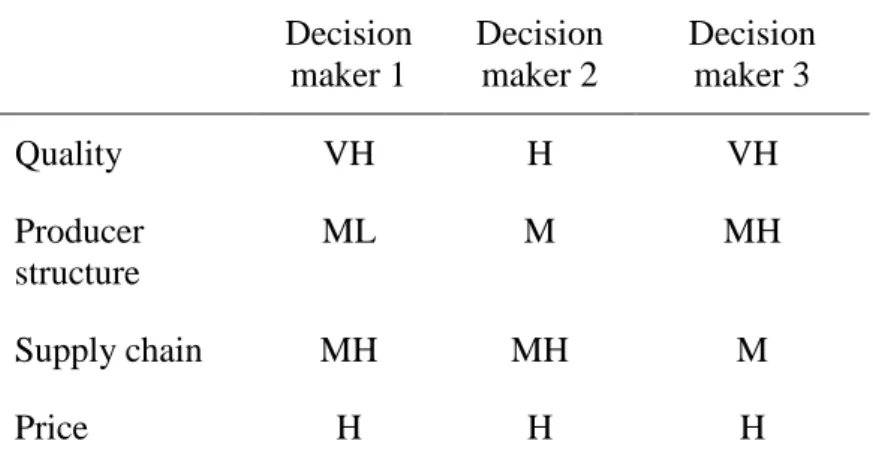Cilt 10, Sayı 2, 2017, 185 –212, DOI : 10.20854/bujse.316308
185
ÜRETİCİ SEÇİM PROBLEMİ: TÜRK GIDA SEKTÖRÜNDEN BİR ÖRNEK
G. Nilay YÜCENUR (nilayyucenur@beykent.edu.tr)
Beyk ent Üniversitesi, Mühendislik Mimarlık Fak ültesi, Endüstri Mühendisliği Bölümü, Ayazağa Kampüsü -İSTANBUL
ÖZET
Kakao çok değerli bir bitkidir. Çünkü kakao, üretildiği ülkeler için önemli bir ihraç ürünü iken iklim şartları nedeniyle kakaoyu üretemeyen ülkeler için de kritik bir ithalat ürünüdür. Bu çalışmada, çok kriterli karar verme (ÇKKV) yöntemlerini uygulayarak Türkiye’de hizmet veren bir çikolata firması için en uygun kakao üreticisini seçmek için model önerilmiş ve önerilen model bulanık ortamda dilbilimsel değişkenlere dayalı olarak Analitik Hiyerarşi Prosesi (AHP), Analitik Ağ Prosesi (ANP) ve VIKOR yöntemleri ile çözülmüştür. 4 ana kriter ve 14 alt kriterden oluşturularak önerilen modelin çözümünde ilk olarak bulanık AHP metodolojisi kullanılmış, ardından ana kriterler arasındaki ilişkileri değerlendirmeye alabilmek için bulanık ANP metodolojisi kullanılmış ve son olarak da araştırmacılara uzlaşmaya dayalı çözüm sunan VIKOR yöntemi yine aynı modelin çözümünde kullanılmıştır. Çalışmada önerilen model açıklanmış, tüm değerlendirmeler ve karşılaştırmalar bulanık mantık temelinde üçgensel sayılarla yapılmış ve bulanık AHP, bulanık ANP ve VIKOR yöntemleri ile elde edilen sonuçlar karşılaştırılabilirlik açısından test edilmiştir.
Anahtar kelimeler: Kakao üreticisi seçimi, Analitik hiyerarşi
prosesi, Analitik ağ prosesi, VIKOR, Üçgensel sayılar, Bulanık kümeler.
Makale Geliş Tarihi: 27.05.2017 Makale Kabul Tarihi: 19.12.2017
Volume 10, Number 2, 2017, 185 – 212, DOI : 10.20854/bujse.316308
186
A PRODUCER SELECTION PROBLEM: A CASE FROM TURKISH FOOD INDUSTRY
G. Nilay YÜCENUR (nilayyucenur@beykent.edu.tr)
Beyk ent University, Faculty of Engineering and Architecture, Industrial Engineering Department Ayazağa Campus-ISTANBUL
ABSTRACT
Cacao is a very valuable crop as cash. Because cacao is an important exportation crop for countries where it is produced and it is a critical importation product for countries which cannot produce cacao because of their unsuitable climate conditions but consuming it. We suggested a model for choosing the appropriate cacao producer for our chocolate firm in Turkey by applying multi-criteria decision making (MCDM) methods: Analytic hierarchy process (AHP), Analytic network process (ANP) and VIKOR based on linguistic variables under fuzzy environment in this paper. All three methods are suggested to be used in our proposed hierarchical model. Firstly, fuzzy AHP methodology is used for analyzing the 4 main criterions and 14 sub-criterions; secondly fuzzy ANP methodology is applied for representing the inter-relationships among these main criterions and the last methodology, VIKOR, is used to find out a compromise solution. The proposed model is explained by illustrative example, all comparisons and evaluations are made with triangular numbers with fuzzy sets and final results of fuzzy AHP, fuzzy ANP and VIKOR are tested for comparability.
Keywords: Cacao producer selection, Analytic hierarchy process,
Analytic network process, VIKOR, Triangular numbers, Fuzzy sets.
Received: 27.05.2017 Accepted: 19.12.2017
1. INTRODUCTION
Cacao is a crucial ingredient for creating chocolate. Cacao is obtained from seeds of the fruits of cacao which are grown on big trees. The cacao beans need hot and humid climate that’s why mostly it’s production area is around the tropical regions like the Equator. This type climate such as hot and humid is suitable for growing cacao trees. 70% of the cacao beans all over the World are grown and sold from four African West countries such as Ghana, Ivory Coast, Cameroon and Nigeria [1].
In Turkey because its climate conditions cacao beans cannot be grown. That’s why cacao beans are very important import crop. In this research paper, a model was suggested for selecting the suitable cacao producer for our chocolate firm in Turkey.
In literature review, there are so many MCDM applications about AHP, ANP and VIKOR with triangular numbers under fuzzy conditions. For example, Beşikçi et al. [2] apply fuzzy AHP to measure ship operational energy efficiency; Ng [3] evaluates of design alternatives’ environmental performances with fuzzy AHP; Keprate and Ratnayake [4] enhance offshore process safety by selecting fatigue critical piping locations for inspection using the same method. Wang et al. [5] evaluate of ship maneuverability by fuzzy ANP; Liou et al. [6] select strategic alliance partner with fuzzy ANP in the airline industry and Dargi et al. [7] select the suitable supplier with the same method. Wu et al. [8] use fuzzy VIKOR for machine tool choosing; Liu et al. [9] study with the same method for failure mode and effects analysis (FMEA).
In literature, we can see the combinations of these techniques. For example, Yücenur et al. [10] use AHP and ANP methods with triangular numbers for supplier selection problem; Rezaie et al. [11] use an integrated fuzzy AHP-VIKOR method to evaluate performance of Iranian firms; Tadic et al. [12] use fuzzy ANP and fuzzy VIKOR with fuzzy DEMATEL for selecting city logistic concept.
Our research model focuses on cacao producer selection among alternative firms for our chocolate firm in Turkey. This is the first study in literature with combining three MCDM methods under
fuzzy environment. We analyzed three producers with fuzzy AHP, fuzzy ANP and VIKOR methodologies used a proposed model with four levels of hierarchy that contains 4 main criterion such as quality, producer structure, supply chain and price and 14 sub-criterion such as sustainable premium quality, production skills and abilities, customer satisfaction, high taste/quality combination, large product range and by product supplying, well-established capital structure, reliability, technical support, sustainable cacao products, innovative ideas and trends, price variety, market knowledge, cross selling possibility, and risk management.
In this research paper, we used fuzzy AHP technique for pairwise matrixes which is based on the linguistic variable and we enlarged our analysis with fuzzy ANP method with analyzing inter-relationships among decision criterion and lastly, we applied VIKOR methodology to find a compromise priority sorting of options due to the selection criterion for our problem with fuzzy sets.
Briefly, after all literature review this paper is constructed for two objectives:
1. The first objective is to propose a hierarchical model for selecting the most suitable cacao producer for our chocolate firm in Turkey,
2. The second objective is to be the first study in literature because of combining all three methods such as AHP, ANP and VIKOR under fuzzy environment for a new research area cacao producer selection.
As an outline: Cacao production, the importance of the cacao for chocolate firms in food industry and some statistic about this sector are introduced in Section 2. Section 3 contains the discussion about proposed model with 4 criterion, 14 sub-criterion and 3 alternative producers. In section 4, three different solution methods such as AHP, ANP and VIKOR are discussed under fuzzy knowledge conditions and the complete implementations of all methods for our multi-criterion selection problem. Section 5 contains the comparisons among three methods results and some conclusion remarks.
2. CACAO PRODUCTION
Cacao is a very important and critical export item for its cash effects for all over the World economies and also it is a very critical import item for some countries which has not a suitable climate condition for cacao production. Cacao beans have a very complex production process which is started from the farmers and continued through with the buyers, shipping organizations, processors, manufacturers and distributors respectively in a Global supply chain [13].
90% of the cacao production comes from small family farms with 2 or 5 hectares, only 5% of the cacao production come from large agricultural area with along 40 hectares or more. For producing cacao around 40-50 million farmers and rural workers and also their families work and live in the Global South with suitable climate for this production [1]. In Table 1, production of cacao beans is represented.
Table 1. Production of cacao beans / thousand tons (2013-2016)
[14]. 2013-2014 2014-2015 (estimates) 2015-2016 (estimates) Africa 3199 73.2% 3068 72.5% 3063 73.7% Cameroon 211 232 230 Cote d’lvoire 1746 1796 1690 Ghana 897 740 840 Nigeria 248 195 200 Others 97 105 103
America 726 16.6% 760 18.0% 714 17.2% Brazil 228 230 210 Equator 234 250 230 Others 264 280 274 Asia & Oceania 447 10.2% 401 9.5% 377 9.1% Indonesia 375 325 300 Papua New Guinea 36 36 36 Others 36 40 41 World total 4372 100.0% 4230 100% 4154 100%
Cacao production provides a huge cash flow among the countries all over the World. For example, on one hand, people who live in Europe and North America import lots of cacao beans from Africa for eating lots of chocolate because their inappropriate climate conditions for growing cacao trees. On the other hand African countries sell and export their cacao to these countries and earn lots of money. In Africa the government uses this cacao income for building schools, hospitals, roads and modernizing their countries with this money [15].
2.1 The importance of the cacao producers for chocolate firms in food industry
The meaning of the chocolate differs for every people: some of them describe it like a special treat or a pleasure. But chocolate means for many people in all over the World that it is a very critical industry and market. According to some researchers, the Global
chocolate market size will be very huge amount worth $98.3 billion at the end of 2016 [16].
Nowadays, people in all over the World like different types of chocolate. For example some of them like German chocolate cake others like Swiss chocolate with aromatic cacao. All around the World, every year more than 3 million tons of cacao beans are produced for consuming whatever types of chocolate. World Cacao Foundation and subsidiary enterprises work for ensuring the continuity of this valuable crop production [17]. The trend of the cacao necessity is increased by chocolate sector in all over the world.
3. PROPOSED MODEL FOR CACAO PRODUCER SELECTION PROBLEM
The proposed model for cacao producer selection problem has a hierarchy with four stages, with four dissimilar criterions, 14 different sub-criterion and the three alternative producer firms will be further discussed. In the hierarchy, the main objective is situated at level 1, criterion are placed at level 2, sub-criterion are placed at level 3 and the alternatives are placed at level 4. The 4 criterion, 14 sub-criterion and 3 decision alternative producers are described below. In Figure 1, the hierarchy of the proposed model is shown.
3.1 Selection criterion for proposed model
The criterions that are considered in this paper are quality, producer structure, supply chain and price. The criterion are denoted by Ci, sub-criterion are denoted by Sj and alternative
producer firms are symbolized by Ak (where, i = 1, 2, 3, 4; j = 1, 2, ..., 14; k = 1, 2, 3). The criterion and sub-criterion and categorized
and examined in this paper can be seen in literature review and professional food sector.
Quality (C1):
Sustainable premium quality (S1) Production skills and abilities (S2) Customer satisfaction (S3)
High taste/quality combination (S4) Producer structure (C2):
Large product range and by product supplying (S5) Well-established capital structure (S6)
Reliability (S7) Supply chain (C3):
Technical support (S8)
Sustainable cacao products (S9) Innovative ideas and trends (S10) Price (C4):
Price variety (S11) Market knowledge (S12) Cross selling possibility (S13) Risk management (S14).
3.2 Cacao producer alternatives for a chocolate firm in Turkey
According to hierarchical model, above explained criterion help in determining the most appropriate cacao producer for a chocolate firm in Turkey. In this research paper, depending on the selection criterion there are three alternative producers for a chocolate firm. They can be submitted as follows: International firm1 (A1), Local
firm (A2), and International firm2 (A3).
The numbers of chocolate manufacturers who have been processing cacao has been reducing since the 1980s. While in 1988-1989, the rate of processed World cacao crop was at 42%, the same rate was at 33% in 1999. 35% of industrial cocoa and chocolate market was dominated by five main groups in 1995. This group number was reduced from 5 to 3 along with 1999. They are Cargill, Barry Callebaut and Archer Daniels Midland (ADM), who are responsible for grinding over 38% of the World’s cacao production [18]. Our international firms are chosen in these three alternatives.
4. THREE DIFFERENT SOLUTIONS WITH TRIANGULAR NUMBERS
In this paper, three different solution methods are used for solving our hierarchical model such as AHP, ANP and VIKOR with linguistic variables under fuzzy environment. In this section, the methodologies and their application steps are described respectively. The results are compared at the end of the section.
4.1 The first solution with fuzzy AHP
AHP is well established methodology that was developed by Saaty in 1977. It has been increasingly utilized to compare alternative solutions with reference to a criterion, in pairwise mode and resulting priorities may be utilized to compare and rank
alternatives, the technique is simple, systematic, scientific, dependable and user friendly [19].
In this paper, Chang’s (1996) extent analysis method which is one of the favorite approaches in fuzzy AHP field are used for our evaluations because of its easier calculation steps and similarities to classical AHP. We used fuzzy AHP for a group criterion, sub-criterion to set up the hierarchical structure by selecting the weights of each criterion in whole decision making process. The weights reflect the related importance of each criterion and hence to be selected carefully.
The steps of Chang’s (1996) extent analysis approach are used in this paper like Demirel et al.’s [20] study.
After the explanation of the fuzzy AHP methodology steps, the questionnaire is used for analyzing the pairwise matrixes and the importance degree of the criterion for each other. In Table 2, fuzzy evaluation matrix is represented with respect to the goal.
Table 2. The fuzzy problem solution matrix with respect to the
goal. Quality Producer structure Supply chain Price Quality 1, 1, 1 5/2, 3, 7/2 3/2, 2, 5/2 2/3, 1, 3/2 Producer structure 2/7, 1/3, 2/5 1, 1, 1 2/5, 1/2, 2/3 2/7, 1/3, 2/5 Supply chain 2/5, 1/2, 2/3 3/2, 2, 5/2 1, 1, 1 2/5, 1/2, 2/3 Price 2/3, 1, 3/2 5/2, 3, 7/2 3/2, 2, 5/2 1, 1, 1 WG = (0.42, 0.04, 0.12, 0.42)T.
After criterion evaluation, the different sub-criterions are compared under each of the criterion separately by following the same procedure as above. The pairwise matrixes are shown in Table 3-6 for all sub-criterions.
Table 3. The fuzzy evaluation matrix with respect to Quality.
Sustainable premium quality Producti on skills and abilities Custom er satisfact ion High taste/qual ity combinat ion Sustainable premium quality 1, 1, 1 5/2, 3, 7/2 3/2, 2, 5/2 2/3, 1, 3/2 Production skills and abilities 2/7, 1/3, 2/5 1, 1, 1 2/5, 1/2, 2/3 2/7, 1/3, 2/5 Customer satisfaction 2/5, 1/2, 2/3 3/2, 2, 5/2 1, 1, 1 2/5, 1/2, 2/3 High taste/quality combination 2/3, 1, 3/2 5/2, 3, 7/2 3/2, 2, 5/2 1, 1, 1 WQ = (0.42, 0.04, 0.12, 0.42)T.
Table 4. The fuzzy evaluation matrix with respect to Producer structure. Large product range and by product supplying Well-established capital structure Reliabi lity
Large product range and by product supplying 1, 1, 1 5/2, 3, 7/2 2/3, 1, 3/2 Well-established capital structure 2/7, 1/3, 2/5 1, 1, 1 2/7, 1/3, 2/5 Reliability 2/3, 1, 3/2 5/2, 3, 7/2 1, 1, 1 WPS = (0.37, 0.26, 0.37)T.
Table 5. The fuzzy evaluation matrix with respect to Supply chain.
Technical support Sustainable cacao products Innovative ideas and trends Technical support 1, 1, 1 2/5, 1/2, 2/3 3/2, 2, 5/2 Sustainable cacao products 3/2, 2, 5/2 1, 1, 1 5/2, 3, 7/2 Innovative ideas and
trends 2/5, 1/2, 2/3 2/7, 1/3, 2/5 1, 1, 1 WSC = (0.17, 0.81, 0.02)T.
Table 6. The fuzzy evaluation matrix with respect to Price. Price variety Market knowledge Cross selling possibility Risk management Price variety 1, 1, 1 2/3, 1, 3/2 3/2, 2, 5/2 5/2, 3, 7/2 Market knowledge 2/3, 1, 3/2 1, 1, 1 3/2, 2, 5/2 5/2, 3, 7/2 Cross selling possibility 2/5, 1/2, 2/3 2/5, 1/2, 2/3 1, 1, 1 3/2, 2, 5/2 Risk managemen t 2/7, 1/3, 2/5 2/7, 1/3, 2/5 2/5, 1/2, 2/3 1, 1, 1 WP = (0.42, 0.42, 0.12, 0.04)T.
Finally, the priority weights of each alternative cacao producers can be calculated by weights per producer multiplied. The producer which has the highest score is the result, it is the best cacao producer for our chocolate firm in Turkey according to our proposed model structure. Table 7 shows the results.
Table 7. Main sub-criterion of the goal. Quality Producer structure Supply chain Price Alternative priority weight Criterion weights 0.42 0.04 0.12 0.42 International firm 1 0.29 0.24 0.45 0.22 0.28 Local firm 0.16 0.11 0.22 0.23 0.20 International firm 2 0.55 0.65 0.33 0.55 0.52
From Table 7, analyzing the combination of priority weights for sub-criterion, criterion and alternative cacao producers to decide priority weights, it is clear that the third alternative, which is International firm 2 is the best cacao producer according to our proposed model.
4.2 The second solution with fuzzy ANP
Analytic network process method gives a framework for describing the interactions and feedbacks among all criteria, alternatives, actors and targets. It is suitable for solving many complex real life problems because of this characteristic [21].
In this paper, fuzzy ANP method is used for producer’s selection problem with making the network structure of criterion. The steps fuzzy ANP methodology is used in this paper like Demirel et al.’s [20] study’ steps likes again Chang’s extend analysis method.
In fuzzy ANP methodology interdependent weights of the criterion are calculated and the dependencies among the criterion are taken into consideration. The pairwise comparison matrix is
formed for quality (Table 8). Similar calculations are also repeated for the other criterion (Table 9-11).
Table 8. From inner dependence matrix of the criterion with
respect to Quality. Producer structure Supply chain Price Producer structure 1, 1, 1 2/7, 1/3, 2/5 2/5, 1/2, 2/3 Supply chain 5/2, 3, 7/2 1, 1, 1 3/2, 2, 5/2 Price 3/2, 2, 5/2 2/5, 1/2, 2/3 1, 1, 1 W1 = (0.02, 0.81, 0.17)T.
Table 9. From inner dependence matrix of the criterion with
respect to Producer structure.
Quality Supply chain Price Quality 1, 1, 1 2/3, 1, 3/2 2/5, 1/2, 2/3 Supply chain 2/3, 1, 3/2 1, 1, 1 2/5, 1/2, 2/3 Price 3/2, 2, 5/2 3/2, 2, 5/2 1, 1, 1 W2 = (0.15, 0.15, 0.70)T.
Table 10. From inner dependence matrix of the criterion with
respect to Supply chain.
Quality Producer structure Price Quality 1, 1, 1 5/2, 3, 7/2 3/2, 2, 5/2 Producer structure 2/7, 1/3, 2/5 1, 1, 1 2/5, 1/2, 2/3 Price 2/5, 1/2, 2/3 3/2, 2, 5/2 1, 1, 1 W3 = (0.81, 0.02, 0.17)T.
Table 11. From inner dependence matrix of the criterion with
respect to Price. Quality Producer structure Supply chain Quality 1, 1, 1 2/5, 1/2, 2/3 3/2, 2, 5/2 Producer structure 3/2, 2, 5/2 1, 1, 1 5/2, 3, 7/2 Supply chain 2/5, 1/2, 2/3 2/7, 1/3, 2/5 1, 1, 1 W4 = (0.17, 0.81, 0.02)T.
The dependence matrix of the criterion is formed with using the computed relative importance weights. Interdependent weights of the criterion are computed by multiplying the dependence matrix of the criterion we obtained with local weights of factors provided in
Table 2. The interdependent weights of the factors are calculated as follows: 26 . 0 24 . 0 20 . 0 30 . 0 42 . 0 12 . 0 04 . 0 42 . 0 00 . 1 17 . 0 70 . 0 17 . 0 02 . 0 00 . 1 15 . 0 81 . 0 81 . 0 02 . 0 00 . 1 02 . 0 17 . 0 81 . 0 15 . 0 00 . 1 Pr Pr ice n Supplychai cture oducerstru Quality
After interdependent weights of criterion calculations, significant differences are observes in the results obtained for the criterion weights in Table 2. The results change from 0.42 to 0.30 for quality, 0.04 to 0.20 for producer structure, 0.12 to 0.24 for supply chain and 0.42 to 0.26 for price.
In this step, global weights are calculated for local sub-criterion by using interdependent weights of the criterion and local weights sub-criterion. For calculating the global sub-criterion weights by multiplying local weight of the sub-criterion with the interdependent weight of the criterion to which it belongs. In Table 12 shows the computed values.
Table 12. Computed global weights of sub-criterion.
Criterion and Local weights Sub-criterion Local weights Global weights Quality 0.30 Sustainable premium quality 0.42 0.13 Production skills and abilities 0.04 0.01
Customer satisfaction 0.12 0.04 High taste/quality combination 0.42 0.13 Producer structure 0.20
Large product range and by product supplying 0.37 0.07 Well-established capital structure 0.26 0.05 Reliability 0.37 0.07 Supply chain 0.24 Technical support 0.17 0.04 Sustainable cacao products 0.81 0.19 Innovative ideas and trends 0.02 0.01 Price 0.26 Price variety 0.42 0.11 Market knowledge 0.42 0.11 Cross selling possibility 0.12 0.03 Risk management 0.04 0.01
Finally, according to the reflection of the interrelations within the criterion, the overall priorities of producers are calculated as follows:
[Producers’ sub-criterion weights][Global weights of sub-criterion] = 52 . 0 18 . 0 30 . 0
The same hierarchical proposed model is analyzed with the fuzzy ANP. According to the fuzzy ANP analysis, optional producers are ordered as International firm 2, International firm 1 and Local firm as the same fuzzy AHP solution.
4.3 The third solution with VIKOR
VIKOR was introduced by Opricovic in 1998. It works by first creating a reconciliation ranking-list, a reconciliation solution and the weight stability intervals for the reconciliation solution. It then decides the positive-ideal solution and the negative-ideal solution to aid in ranking and selecting. Like other multi criteria decision making techniques such as AHP and ANP, the VIKOR method was also extended to accommodate subjectivity and imprecise data under fuzzy environment [22].
In this paper, the main steps of the algorithm are taken from Sanayei et al.’s [23] study. Firstly, identify the objectives, secondly arrange the decision making group, thirdly identify the appropriate linguistic variables
The decision makers’ use for evaluating the importance of the criterion and obtaining the ratings of options with respect to qualitative criterion the linguistic variables are shown in Table 13.
Table 13. Linguistic variables and fuzzy numbers.
Linguistic variables for importance weight of each
criterion
Linguistic variables for ratings
Linguistic variables Fuzzy numbers Linguistic variables Fuzzy numbers Very low Low Medium low Medium Medium high High Very high VL L ML M MH H VH (0.0 – 0.1 – 0.2) (0.1 – 0.2 – 0.3) (0.2 – 0.3 – 0.4 – 0.5) (0.4 – 0.5 – 0.6) (0.5 – 0.6 – 0.7 – 0.8) (0.7 – 0.8 – 0.9) (0.8 – 0.9 – 1.0) Very poor Poor Mediu m poor Fair Mediu m good Good Very good VP P MP F M G G VG (1.0 – 0.1 – 0.2) (0.1 – 0.2 – 0.3) (0.2 – 0.3 – 0.4 – 0.5) (0.4 – 0.5 – 0.6) (0.5 – 0.6 – 0.7 – 0.8) (0.7 – 0.8 – 0.9) (0.8 – 0.9 – 1.0)
Fourthly pull the decision makers’ opinions to get the aggregated fuzzy weights of criterion, and aggregated fuzzy ratings of alternatives and construct a fuzzy decision matrix, fifthly defuzzification by using center of area defuzzification method, sixthly determine the best (
j
f ) and the worst (fj) values of all
criterion ratings, seventhly calculate Si and Ri values, eighthly
calculate Qi value, rank the alternatives, sorting by the values S, R
and Q in ascending order.
The proposed model has been used to cacao producer selection problem for a chocolate firm in Turkey. Three decision makers use the linguistic weighting variables and in Table 14 and Table 15 the linguistic evaluations are shown.
Table 14. Importance weight of criterion from three decision makers. Decision maker 1 Decision maker 2 Decision maker 3 Quality VH H VH Producer structure ML M MH Supply chain MH MH M Price H H H
Table 15. Ratings of the three alternative firms from three decision
makers under the various criterions.
Quality Producer structure Suppl y chain Price Decision maker 1 Internation al firm 1 G MG VG MG Local firm MP P VP G Internation al firm 2 VG F MG F Decision maker 2 Internation al firm 1 MG MG G F Local firm P P MP VG Internation al firm 2 G MG G F
Decision maker 3 Internation al firm 1 G MG MG MP Local firm MP MP VP VG Internation al firm 2 VG F G MG
Linguistic evaluation is converted to trapezoidal fuzzy number. Then, the weights of the criteria and the fuzzy rankings of alternatives are calculated to construct fuzzy decision matrix. After constructing the matrix with defuzzification step the crisp values for decision matrix, weight of each criterion and the best and the worst values of all criterion ratings are computed as shown in Table 16.
Table 16. Crisp values for decision matrix, weight and the best and
the worst values of each criterion. Quality Producer structure Supply chain Price Weights 0.88 0.50 0.60 0.80 International firm 1 0.73 0.65 0.77 0.50 Local firm 0.30 0.28 0.22 0.88 International firm 2 0.88 0.58 0.73 0.58 f 0.88 0.65 0.77 0.88 f 0.30 0.28 0.22 0.50
With obtained f and f values the value of S, R and Q are
calculated for all optional cacao producer firms as shown in Table 17.
Table 17. The values of S, R and Q for all alternative firms and the
ranking of the alternatives. International
firm 1
Local firm International firm 2 S 1.03 1.98 0.76 R 0.80 0.88 0.63 Q 0.45 1.00 0.00 Ranking alternatives 2 3 1
By Q value decreasing order, International firm 2 is the best cacao producer firm for our chocolate firm in Turkey according to our proposed model and the alternative firms after this are International firm 1 and Local firm, respectively. After all calculations in Table 18 results are shown which were obtained by fuzzy AHP, fuzzy ANP and fuzzy VIKOR methods.
Table 18. Weights and ranking of the alternative firms with three different solutions. International firm 1 Local firm International firm 2 Weights in AHP 0.28 0.20 0.52 Rankings in AHP 2 3 1 Weights in ANP 0.30 0.18 0.52 Rankings in ANP 2 3 1 VIKOR (Q values) 0.45 1.00 0.00 Rankings in VIKOR 2 3 1 5. CONCLUSION
Small holder farmers plant cacao crops for growing up and exporting all over the World from tropics such as Latin America, West Africa and Indonesia because of their suitable climate conditions. Cacao is very important and fundamental production good of chocolate industry. That’s why this paper is about cacao producer selection problem and its numerical applications with multi criteria decision making methods for our chocolate firm in Turkey.
This study presents the ranking of three alternative cacao producer firms with four main-criterions and fourteen sub-criterions.
The paper is the first study in literature on one hand the paper uses three different MCDM methods with triangular numbers in fuzzy environment on the other hand this combination adapts cacao producer selection in food industry as a first application area.
As a conclusion, according to the final score in all three analysis International firm 2 is the most suitable producer for our chocolate firm in Turkey according to our proposed hierarchical model because it has the highest priority weight for fuzzy AHP and fuzzy ANP techniques and lowest Q value for VIKOR. International firm 1 is the next recommended cacao producer.
This paper is the first study due to its solution techniques in sectoral manner such as AHP/ANP/VIKOR under fuzzy environment. Our research paper, will shed light for different implementation of the selection problems in agricultural field with similar techniques in future researches.
REFERENCES
[1] Make Chocolate Fair, European Campaign for Fair Chocolate, http://makechocolatefair.org/issues/cocoa-production-nutshell, Arrival Date: 16.11.2016.
[2] Beşikçi, E.B., Kececi, T., Arslan, & O., Turan, O. (2016). An application of fuzzy AHP to ship operational energy efficiency measures, Ocean Energy, 121, 392-402.
[3] Ng, C.Y. (2016). Evidential reasoning-based fuzzy AHP approach for the evaluation of design alternatives’ environmental performances, Applied Soft Computing, 46, 381-397.
[4] Keprate, A. & Ratnayake, R.M.C. (2016). Enhancing offshore process safety by selecting fatigue critical piping locations for inspection using fuzzy-AHP based approach, Process Safety
[5] Wang, X., Liu, Z. & Cai, Y. (2015). A rating based fuzzy Analytic Network Process (F-ANP) model for evaluation of ship maneuverability, Ocean Engineering, 106, 39-46.
[6] Liou, J.J.H., Tzeng, G.-H., Tsai, C.-Y. & Hsu, C.-C. (2011). A hybrid ANP model in fuzzy environments for strategic alliance partner selection in the airline industry, Applied Soft Computing, 11(4), 3515-3524.
[7] Dargi, A., Anjomshoae, A., Galankashi, M.R., Memari, A. & Tap, M.B.M. (2014). Supplier selection: A Fuzzy-ANP approach, Procedia Computer Science, 31, 691-700.
[8] Wu, Z., Ahmad, J. & Xu, J. (2016). A group decision making framework based on fuzzy VIKOR approach for machine tool selection with linguistic information, Applied Soft Computing, 42, 314-324.
[9] Liu, H.-C., You, J.-X., You, X.-Y. & Shan, M.-M. (2015). A novel approach for failure mode and effects analysis using combination weighting and fuzzy VIKOR method, Applied Soft
Computing, 28, 579-588.
[10] Yücenur, G.N., Vayvay, Ö. & Demirel, N.Ç. (2011). Supplier selection problem in global supply chains by AHP and ANP approaches under fuzzy environment, The International
Journal of Advanced Manufacturing Technology, 56(5-8), 823-833.
[11] Rezaie, K., Ramiyani, S.S., Nazari-Shirkouhi, S. & Badizadeh, A. (2014). Evaluating performance of Iranian cement firms using an integrated fuzzy AHP-VIKOR method, Applied
Mathematical Modelling, 38 (21-22), 5033-5046.
[12] Tadic, S., Zecevic, S. & Krstic, M. (2014). A novel hybrid MCDM model based on fuzzy DEMATEL, fuzzy ANP and fuzzy VIKOR for city logistics concept selection, Expert Systems with
[13] World Cocoa Foundation, (2014).
www.worldcocoafoundation.org/wp-content/uploads/Cocoa-Market-Update-as-of-4-1-2014.pdf, Arrival Date: 16.11.2016. [14] International Cocoa Organization, www.icco.org/about-
us/international-coca-agreements/cat_view/30-related-documents/46-statistics-production.html, Arrival Date: 16.11.2016. [15] Food and Agriculture Organization of the United Nations, www.fao.org/docrep/006/AD220E/AD220E01.htm, Arrival Date: 16.11.2016.
[16] World Atlas, Top 10 Cocoa Producing Countries,
www.worldatlas.com/articles/top-10-cocoa-producing-countries.html, Arrival Date: 16.11.2016.
[17] World Cocoa Foundation, History of Cocoa, www.worldcocoafoundation.org/about-cocoa/hstory-of-cocoa/, Arrival Date: 16.11.2016.
[18] Anti-Slavery International, (2004). The cocoa industry in West Africa: A history of exploitation, www.antislavery.org/includes/documents/cm_docs/2008/c/cocoa_r eport_2004.pdf, Arrival date: 16.11.2016.
[19] Kumar, S., Luthra, S., Haleem, A., Mangla, S.K. & Grag, D. (2015). Identification and evaluation of critical factors to technology transfer using AHP approach, International Strategic
Management Review, 3, 24-42.
[20] Demirel, N.Ç., Yücenur, G.N., Demirel, T. & Muşdal, H. (2012). Risk-based evaluation of Turkish agricultural strategies using Fuzzy AHP and Fuzzy ANP, Human and Ecological Risk
Assessment, 18, 685-702.
[21] Koç, E. & Burhan, H.A. (2016). Analytic Network Process in location selection and its application to a real life problem,
International Journal of Computer, Electrical, Automation, Control and Information Engineering, 10(3), 460-465.
[22] Afful-Dadzie, E., Nabareseh, S., Oplatkova, Z.K. & Klimek, P. (2016). Model for assessing quality of online health information: A fuzzy VIKOR based method, Journal of
Multi-Criterion Decision Analysis Optimization, Learning and Decision Support, DOI: 10.1002/mcda.1558.
[23] Sanayei, A., Mousavi, S.F. & Yazdankhah, A. (2010). Group decision making process for supplier selection with VIKOR under fuzzy environment, Expert Systems with Applications, 37, 2257-2262.
